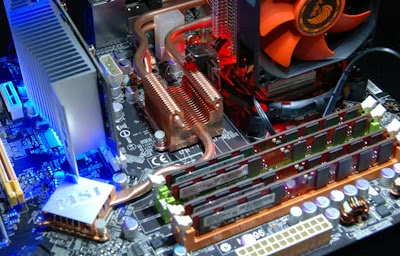Ever watched a tech guy open a computer like he’s performing heart surgery and thought, “What on earth am I looking at?”
Yeah. Me too.
The first time I opened a desktop tower, I was hit with a maze of wires, fans, and mysterious green slabs. I poked around (gently, I promise), hoping to magically “just get it.” Spoiler: I didn’t. Not at first.
But here’s the thing: understanding what’s inside your computer isn’t just for IT pros or curious teenagers trying to build their first gaming rig. Whether you're a small business owner, a casual user, or a budding content creator, knowing what each computer part does can save you time, money, and a whole lot of Googling.
Let’s break it down in a simple, non-boring way. No jargon overload. No geek gatekeeping. Just straight-up answers to: What does this part do, and why should I care?
🧠 The Brain: CPU (Central Processing Unit)
Imagine your computer as a kitchen. The CPU? That’s the chef.
Everything—from opening Chrome to running Zoom to editing a photo—goes through the CPU. It reads, calculates, processes, and executes all the instructions thrown at it. And fast.
Key Functions:
-
Executes programs and processes tasks
-
Handles calculations and logic
-
Directs other parts of the computer
Real Talk:
If your computer feels sluggish, your CPU might be overworked. Think of it trying to cook a seven-course meal with one hand tied behind its back.
Pro Tip: For everyday tasks, a mid-range CPU (like an Intel Core i5 or AMD Ryzen 5) is plenty. But for gaming, video editing, or running heavy apps? Go for higher-end options with more cores and threads.
🧠 Part 2: GPU (Graphics Processing Unit)
Also known as the graphics card—and no, it's not just for gamers.
The GPU specializes in handling anything visual: videos, animations, images, and, of course, those silky-smooth 60+ fps gaming sessions. Designers, video editors, and even crypto miners lean heavily on GPUs.
What It Does:
-
Renders graphics and visual effects
-
Assists in 3D modeling, CAD, and video rendering
-
Supports multi-monitor setups
True Story:
My friend Sarah is a wedding photographer. She used to export high-res photos on her old laptop—each file taking 15 minutes. Upgraded to a PC with a solid GPU, and she’s down to under 2 minutes per export. Time is money, folks.
🧩 The Mother of All Boards: Motherboard
If your computer were a concert, the motherboard would be the stage crew. Nothing flashy, but without it, nothing works.
The motherboard connects every component—CPU, RAM, GPU, hard drives, and fans—and makes sure they can talk to each other.
What It Does:
-
Acts as the central circuit hub
-
Controls communication between parts
-
Houses input/output ports
Things to Look For:
-
CPU socket compatibility (Intel vs AMD)
-
RAM slots and max capacity
-
Expansion slots (PCIe for GPUs, etc.)
-
USB, Ethernet, and audio ports
Pro Tip: A good motherboard won’t make your PC faster, but a bad one can bottleneck it. Go for reputable brands like ASUS, MSI, or Gigabyte.
⚡️ RAM (Random Access Memory): Your Computer’s Short-Term Memory
Here’s a fun metaphor: RAM is like your desk space. The bigger it is, the more stuff you can have open and use quickly.
So when you’ve got 37 Chrome tabs, a Spotify playlist, a Zoom call, and three Word docs open—RAM is working hard to keep it all flowing.
What RAM Does:
-
Temporarily stores active data for quick access
-
Allows multitasking without lag
-
Speeds up application performance
How Much Do You Need?
-
8GB: Fine for casual users (web, docs, light gaming)
-
16GB: Great for most users (productivity, multitasking)
-
32GB+: For creative professionals, gamers, and developers
💾 Storage: SSD vs. HDD—What’s the Difference?
Let’s keep it simple.
-
HDD (Hard Disk Drive): Old-school, slower, more space for less money
-
SSD (Solid State Drive): Newer, way faster, no moving parts
SSDs Are Great For:
-
Faster boot-up and app loading
-
Overall snappier performance
-
Laptops (more durable, uses less battery)
I once replaced an old laptop’s HDD with a cheap SSD. It went from 3 minutes to boot up to 15 seconds. Felt like I’d bought a new machine.
Pro Tip: If possible, use a small SSD (e.g., 500 GB) for your operating system and apps and a larger HDD (e.g., 1 TB+) for media and backups.
🔌 Power Supply Unit (PSU): The Unsung Hero
Boring? Maybe. Critical? Absolutely.
The power supply unit feeds electricity to your whole system. Get a bad one, and you risk crashes—or worse, frying your components.
What to Look For:
-
Wattage (match it to your system’s needs)
-
80+ efficiency ratings (Bronze, Gold, Platinum)
-
Modular cables (for better airflow and tidiness)
Don’t cheap out on this. It’s the difference between a stable setup and randomly losing hours of unsaved work. Trust me, it stings.
❄️ Cooling System: Keeping Things Chill
Heat is the enemy of performance.
Your CPU and GPU generate a lot of it. Without proper cooling, your system slows down (thermal throttling) or just shuts off mid-task.
Types of Cooling:
-
Air Cooling: Fans and heatsinks; cheap and effective
-
Liquid Cooling: More efficient and quiet, but pricier and requires careful setup
Real-Life Hack: Even if you're not gaming, regularly cleaning dust from your fans makes a difference. I once blew out a layer of dust and dropped my idle temps by 15°C.
🖥️ Monitor, Keyboard, Mouse: The Interface Crew
You interact with these daily, but they often get the least attention.
Monitor Tips:
-
Refresh rate (higher = smoother)
-
Resolution (1080p is fine, 4K for creatives)
-
Panel type (IPS for color accuracy, TN for speed)
Keyboard & Mouse:
If you're typing all day, invest in a keyboard that doesn’t make your fingers hate you. Your wrists will thank you later.
🧰 Optional But Awesome Extras
-
Sound card: Audiophiles or streamers might benefit
-
Capture card: For gamers or content creators
-
Wi-Fi/Bluetooth cards: Especially if your motherboard doesn’t have them built-in
-
External Storage Drives: For backups and portability
So, what does it all mean?
Building or upgrading a computer isn’t some mystical art. It’s just understanding what each part does and matching that to how you use your machine.
And honestly? It can be kind of fun. Once you know what’s going on under the hood, you stop feeling powerless every time something lags or freezes. You start solving problems instead of panicking.
🧠 Quick Recap—Remember These Key Points:
-
CPU, GPU, RAM, and storage form the core of your computer’s speed and performance.
-
The motherboard, PSU, and cooling system keep everything running smoothly and safely.
-
Upgrading to an SSD, cleaning dust, and having enough RAM are easy wins for better performance.
Next time someone opens up a PC and says, “This is the CPU,” you can nod like a pro. Maybe even crack a joke about your CPU needing more coffee.
Who knows? You might even build your own rig someday.
For any query, you can leave comment or contact us personally.

.webp)



